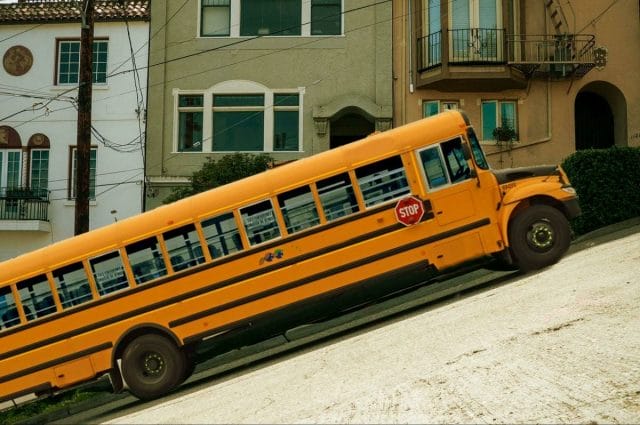
Photo by Jumilla, Josan Pinaster; adapted by Rosie Cima for Priceonomics
Grattan Elementary school is one of the crown jewels of the San Francisco public school district.
It has a lot going for it: a high ratio of teachers to students, an organic garden, enrichment programs that include choir, dance, technology, and “integrated drama,” high standardized test scores, and—despite being a public school—an enormous budget, courtesy of aggressive fundraising by its Parent-Teacher Association.
The school’s elite status is reflected in its admissions statistics. In San Francisco’s school assignment system, parents of students entering the public school system rank their school preferences, and are matched with schools in a system designed to promote equal opportunity. Every year, lots and lots of parents rank Grattan. In the 2015 school year, Grattan had 1,342 applicants for only 65 spots. The resulting admissions rate of 5% was lower than Harvard’s.
But back in the late 1990s and early 2000s, Grattan was struggling. The school’s scores were lackluster, its enrollment was dangerously low, and it was unpopular, especially among affluent white families.
The school was a prime example of a troubling trend. The children of San Francisco were becoming increasingly segregated. Though the neighborhood surrounding Grattan had a sizable white population, the school’s largest racial/ethnic groups were black and asian.
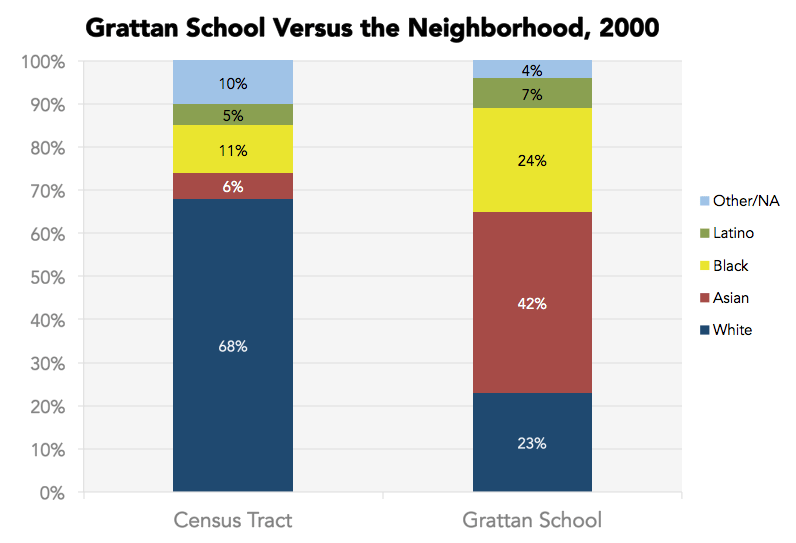
In 2000, the 18 and under population in the census tract surrounding Grattan was much whiter than the demographics of Grattan school; Graphic by Rosie Cima, Priceonomics; Data from California Department of Education, US Census 2000
Many of the more affluent, white families in the neighborhood sent their children to private schools. “Or they were going to public schools that looked better on paper,” Jean Robertson, Grattan’s principal from 2000 to 2011, says. “They certainly weren’t going to Grattan School, that’s for sure.”
Then something happened that should have spelled disaster for an under-attended school: the local economy collapsed.
Between January 2000 and mid 2001, nine-tenths of the dot-com companies in San Francisco went under. Tens of thousands of tech employees lost their jobs, people left the city in droves, and company headquarters sat empty for years. The housing market plummeted on the heels of the tech bubble bursting, and the national recession of the early 2000s soon followed.
But the economic downturn didn’t destroy the school. On the contrary, it probably indirectly saved Grattan.
Educational research suggests that integrating white students into poorer schools attended by minorities is one of the surest ways to improve those schools and benefit minority students. After the dot-com collapse, some impacted families stayed in San Francisco, but started attending public school. As a result, Grattan’s demographics shifted: wealthier, white students entered the school. And the school soon began to improve dramatically.
Grattan was an increasingly diverse and successful school. Unfortunately, things didn’t stop there. Today, the school is one of the highest performing elementary schools in the city, but it’s also one of the whitest and the most affluent — an “elite” “white” school in a mostly minority school district.
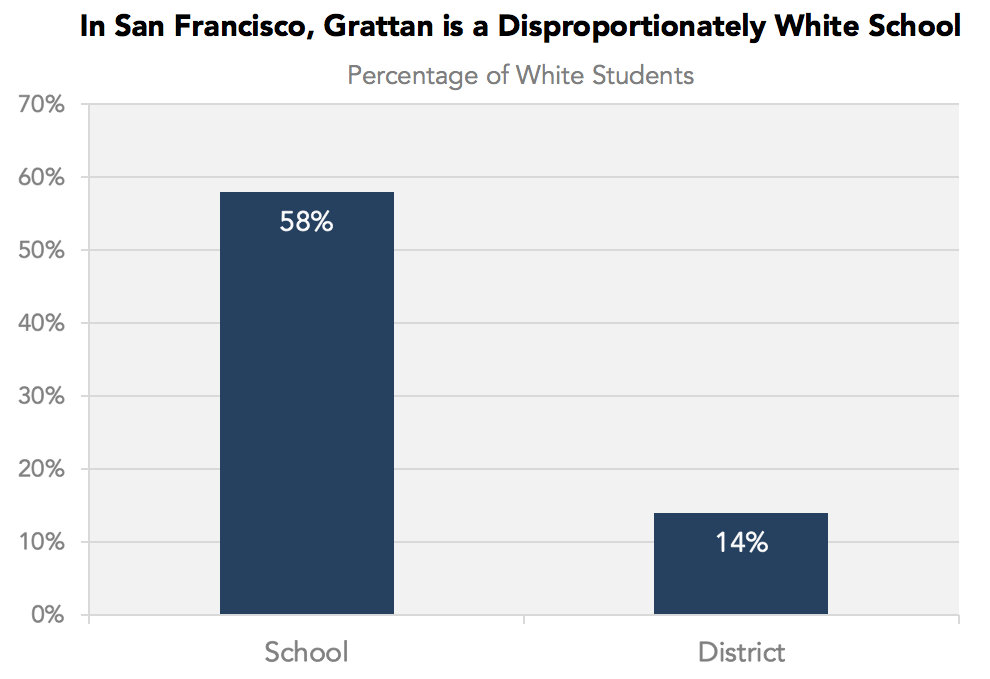
Percent of students who are white at Grattan versus in San Francisco Unified School District, 2015-2016. Graphic by Rosie Cima, Priceonomics; Data from California Department of Education
In the meantime, the city’s overall trend towards racial isolationism has only gotten worse. According to a report in San Francisco Public Press, at almost a third of the public schools in the city, one racial group dominates the student body with a 60% share or more. There are public schools in San Francisco—a city where African Americans make up around 6% of the overall population—where 70% or more of the students are black. The district is still racially segregated; it’s just that Grattan is now on the white side of the color line.
This is a troubling sign. According to education research, integration improves schools, and it seems like one of the best ways to improve education for minority students and ensure racial and economic equity. But that can’t work if, once a school improves, minority students no longer have access to it.
Grattan’s history shows that when a successfully integrated school starts to succeed, a new challenge arises: the challenge of maintaining diversity.
Accidental Desegregation…in San Francisco, 2001

A view of Cole Valley, San Francisco (Robin Sloan)
In the first few years of Principal Robertson’s tenure, in the early 2000s, the city ran a bus to Grattan from the west side of San Francisco, where there weren’t enough schools. Most of the students on what Robertson calls the “bus from the beach” were asian. And every morning, Robertson would see an outgoing bus next to the one coming in: neighborhood kids, mostly white, leaving for a “better” school several miles away.
“It really irked me,” Robertson says, “Why wouldn’t you go to this school?”
Even with that bus from the beach, Grattan’s enrollment numbers were too low, and they were dropping. If something didn’t change, school closure was on the horizon. Early on, Robertson and her administration made many efforts attract local, affluent, white families to Grattan. To hear Robertson tell it, Grattan in the early 2000s bore a strong resemblance to a Disney Channel movie about diversity and teamwork.
“We had a meeting where we discussed it,” Robertson remembers. “We said: We have a great school, it has a wonderful foundation, there’s a lot of love in this building. How are we going to build on it?”
They hosted community yard sales and student performances to draw parents into the school. Parents with culinary skills catered gatherings and held bake sales, one parent with web design skills remade the school website, and another parent coached the school soccer team.
“The Grattan Eagles were the very first public school team in the local recreational league,” Robertson says. “The other teams were all boys, but we had girls on our team, too. That first year, we won the championship.”
Even so, attracting parents to the school was an uphill battle.
One reason local parents avoided Grattan was that it looked lackluster “on paper.” It wasn’t one of the worst schools, but it also wasn’t one of the best. Compared to other schools, Grattan received mediocre marks on the Academic Performance Index (API)—California’s measure of school performance and progress. In 1999, Grattan scored 676, one point below the district median. Rooftop Academy, to which many neighborhood kids were being bused, received a score of 808. Rooftop also had one of the highest concentrations of white students in the district.
Local, white families might never have started attending Grattan in significant numbers if not for a major economic event: the dot-com bubble burst.
“I can’t begin to tell you how many people came in and said they lost their job,” Robertson says. All of a sudden, a lot of parents who had been paying for private school couldn’t afford tuition. And they ended up at Grattan. This was the upside to the devastating economic crash: for a preciously brief window of time, San Francisco’s economic elite became a little less cloistered.
“These families found themselves having to ‘slum it’ at the neighborhood school,” Robertson says, laughing. “But I tell you, every one of them was thrilled in the end.”
How San Francisco’s School Assignment System Happened
Because of the “lottery” assignment system in San Francisco, how a kid ends up in a particular public school isn’t straightforward. Though the system seems complicated, many major American cities—Boston, Seattle, Atlanta—have similar systems. “Lotteries” arose out of a long history of desegregation efforts, but they continue to produce increasingly segregated school systems.
Before 1971, San Francisco school assignment worked the same way it still does in suburbs across America: students attended their neighborhood school. The problem was that San Francisco was geographically segregated. The resulting racial isolation of schools was more extreme than it is today, but the phenomenon was essentially the same. According to a case brought against the district in 1969, black students were particularly isolated in resource-poor schools. Eighty percent of the black students in San Francisco were concentrated in 27 schools, out of “more than one hundred” schools. (Today, eighty percent of the black students in the district are concentrated in 54 schools, out of 118 schools.)
In 1971, following the precedent set by Swann v. Charlotte-Mecklenburg Board of Education, the court ordered San Francisco to implement a mandatory busing program. In order to desegregate the system, students were forced to enroll in schools outside their neighborhood.
The busing system had major drawbacks. The biggest was that, like busing programs across America, it was extremely unpopular. Families of means left the San Francisco public school system for the suburbs or for private schools on a massive scale. In 1978, a federal judge ended the busing program on the grounds that it was no longer necessary, and, in 1979, California voters outlawed forced busing in a ballot proposition.

A school segregation protest
Over the next few decades, the city tried many more means of promoting diversity. This included a variety of racial quota systems. But in a 1990s lawsuit, a Chinese-American student claimed to have been denied admission to a prestigious San Francisco public high school on the basis of his race. As the result of this lawsuit, the district was barred from using race in school assignments, which ended the reign of quota systems.
In 2001, the district introduced a “lottery” system, in which parents ranked schools and a complicated diversity-optimizing program matched them with their choices. This “diversity index” lottery pursued racial diversity through indirect measures like parents’ language and income.
The lottery system was also unpopular with parents, who said they wanted more choice and better predictability from their school assignment system.
Even worse, it didn’t work: the district was becoming more segregated than ever. From 2008 to 2010, a district committee on student assignment met monthly to evaluate the student assignment policy. The committee concluded that “to reverse the trend of racial isolation […] through student assignment alone […] the Board would need to assign students to schools they have not historically requested and to schools far from where they live.” According to the report, forced busing (or something like it) was the only way to fight racial isolationism. The Board of Education, an elected body, did not implement any such policy.
But for Grattan Elementary School, the diversity index lottery did end up diversifying the school.
The Importance of Integration
Robertson thinks school performance improved over the years because of a strong and well-directed school community. “We built out our own capacity,” she says. “We found our strengths, and we used them to build out others.” But education research suggests it also had a lot to do with the school’s changing demographics.
“The research tells us that socio-economic integration is really, really important,” Jill Wynns says. Wynns has served on the San Francisco Board of Education since 1992, making her its most senior member. “A socioeconomically integrated school is one of the best things you can do for a poorer kid.”
The idea is that the biggest problem with racial isolationism is that it goes hand-in-hand with economic isolationism. Black and Latino schools tend to be “high poverty,” which means 75% or more of the students qualify for free or reduced-price lunch. According to a recent government study, high poverty, racially isolated schools with high black and Latino populations have been on the rise nationally since 2000.
These schools tend to be worse than other schools by many measures. According to the study, they have fewer upper level courses and teachers who tend to be less experienced, less qualified, and who tend to take more time off. The students can also hold each other back. Kids who grow up in poverty tend to be more stressed-out and therefore do worse in school, and students at high poverty schools have less opportunity to learn from—or through proximity to—their peers.
“If you’re surrounded by a bunch of kids who are all behind, you stay behind,” journalist Nikole Hannah Jones explained on an episode of This American Life. “But if you’re in a classroom that has some kids behind and some kids advance, the kids who are behind tend to catch up. These kids in these classes in schools with concentrated poverty don’t have that.”
If enough middle class kids enter a high-poverty school, it becomes a mixed-income school. The more affluent families have the time and money to volunteer, fundraise, and petition staff, administrators, and politicians to improve the school. And the lower class families benefit, too.
“What integration does is it gets black kids in the same facilities as white kids,” Jones said. “And therefore, it gets them access to the same things that those kids get: quality teachers and quality instruction.”
Jones cites research, including a study by Rucker Johnson, a public policy professor at UC Berkeley. Johnson’s study tracked people who were kids during the 1970s and the 1980s through to 2011. By comparing people based on whether they attended a court-ordered, desegregated school, he was able to find some strong data in favor of integration. As Jones wrote in The Atlantic:
“[Johnson] found that black Americans who attended schools integrated by court order were more likely to graduate, go on to college, and earn a degree than black Americans who attended segregated schools. They made more money […] They were significantly less likely to spend time in jail. They were healthier. […] Rucker also found that black progress did not come at the expense of white Americans—white students in integrated schools did just as well academically as those in segregated schools.”
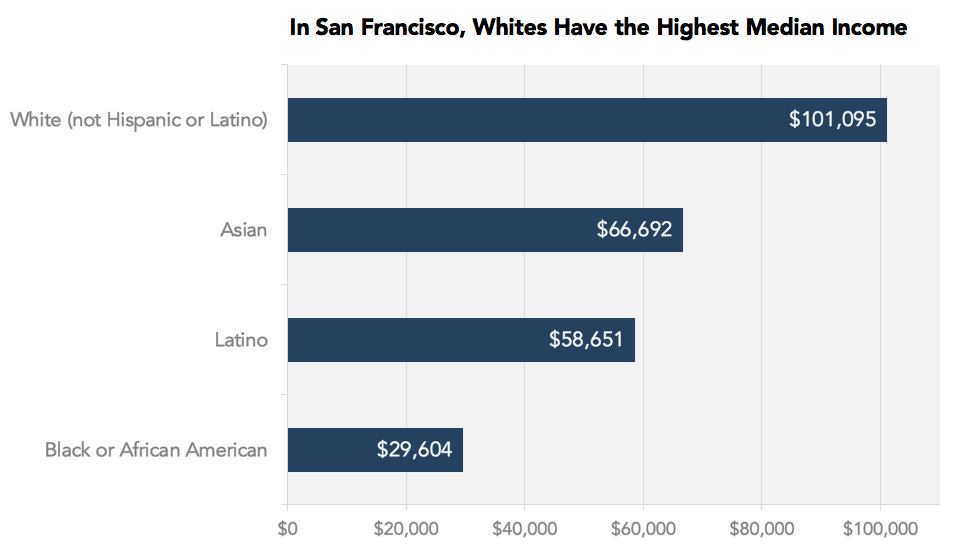
Median income by race/ethnicity; Graphic by Rosie Cima, Priceonomics; Data from American Community Survey 2014
In San Francisco, non-hispanic whites, as a demographic, have a much higher median income than any other racial or ethnic group. And, as it turns out, following the flow of white students is a pretty good predictor of improved test scores. The schools in the district with the largest improvements in performance between 2000 and 2012 also tended to have the highest growth in the percentage of the student body that was white. Eight out of the 10 schools that improved to an unusually high degree (a standard deviation above the mean change in API) also gained white students at an unusually high rate.
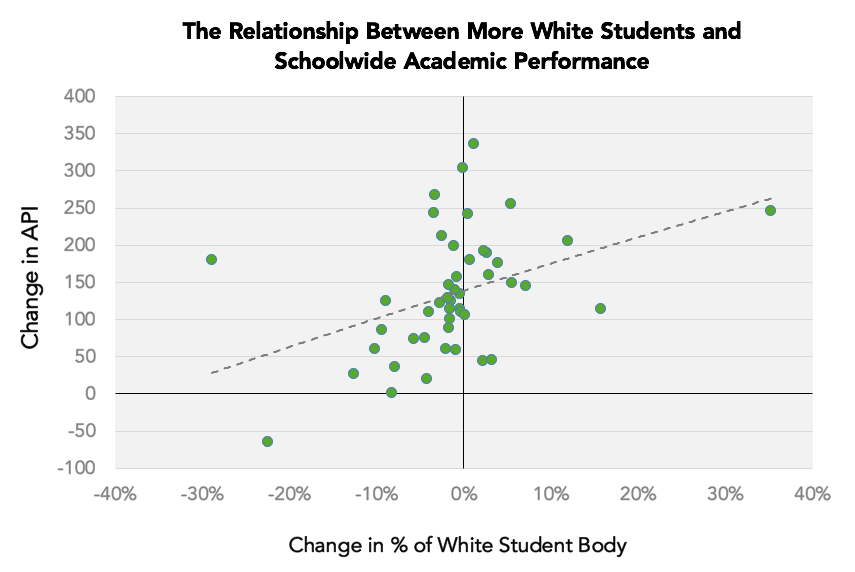
San Francisco schools, with the change in white students as a demographic plotted against improvement in API, 2000 to 2012; Graph by Rosie Cima, Priceonomics. Data from California Department of Education
Grattan’s share of white students increased by 35 percentage points (from 20% to 55% of the student body) from 2000 to 2012, and its API improved by 246 points (from 676 to 922). The overall correlation doesn’t prove causation, but it certainly shows that white students and good outcomes often go hand in hand.
How Grattan Became a “Good” School
Grattan wasn’t a “high poverty” school in 2000. Only 37% of its students qualified for free and reduced-price lunch. (The definition of high poverty is 75%, and the district average at the time was 41%.) But the main reason affluent parents avoided it—lower test scores—had to do with it not having as many resources or as affluent a student body as its private or elite public counterparts.
The first of the white, middle class families to enter Grattan following the tech bubble burst weren’t rich. A lot of them were there because they just couldn’t afford private school anymore. But their kids had grown up with a lot of educational resources, which they were now bringing to Grattan’s classrooms. Compared to the existing students, they were “advanced.”
It also quickly became apparent that they had more affluent networks. Robertson admits that the school and its Parent Teacher Association (PTA) got astronomically better at fundraising during her decade-long tenure. Once the local tech economy rebounded, Grattan benefitted. When Robertson started out, they were hosting small rummage sales and bake sales. But by the 2008 recession, PTA fundraising had graduated to silent auctions. The money from fundraising was enough to allow Grattan to maintain its academics and actually expand its staff and its infrastructure in the midst of statewide budget cuts.
And it didn’t stop there. These days Grattan has a budget even private schools would envy—in the 2012-2013 school year, its PTA had a budget of $353,000.
The economic integration theory of Grattan’s improvement and Robertson’s story about a strengthened school community are actually compatible. It seems that Grattan improved because its students and families became proportionately whiter, and, by proxy, proportionately wealthier. And, on the community side, they invested both money and non-monetary resources like time and energy into the school. And, for a while, the school they helped support was very diverse.
“It was so so so sweet,” Robertson remembers, “when we had a really well-balanced, integrated school. There were a few years where it was the honeypot, and we were really building that school.”
And then the school started to change.
How Grattan Became a “White” School
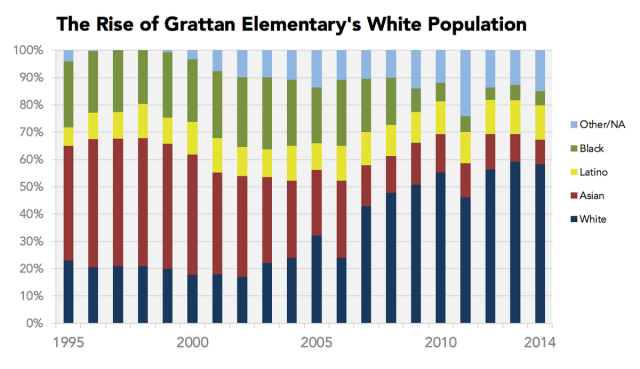
Grattan’s student body, 1995-2016; Graph by Rosie Cima, Priceonomics; Data from the California Department of Education
“We’re a victim of our own success,” Board of Education member Rachel Norton has said of Grattan. The school improved so much that when San Francisco’s economy recovered from the crash, Grattan rivaled both the public schools and the private schools it used to lose neighborhood students to. It was starting to attract students from across the city—not just the neighborhood. Those students continued to be disproportionately white, and, unlike in 2000, when enrollment was dwindling, the school was beginning to fill up.
Soon, things started to tip. “I remember coming to work one day, around when people had been reading The Tipping Point,” Robertson says. The book, by Malcolm Gladwell, is about how small, incremental change can unexpectedly result in big consequences after a threshold is passed.
“One of my veteran teachers turned to me and said, “I’m feeling it. I think we’re tipping,” Robertson says. “And I said, ‘I feel it too.’”
The city stopped running the mostly asian “bus from the beach,” some local black families moved to the suburbs because of housing prices, and white students kept flocking to the school. Within a few years, Grattan was a majority white school in a minority white city.
There’s a big question at work here. Namely: how do people who seem to value diversity end up creating segregated systems? Nobody at Grattan, least of all the staff, wanted to make a disproportionately white school. In fact, many people were attracted to the school specifically for its diversity. And the school assignment system was designed to actively fight racial isolationism.
But as the statistician Thomas Schelling has shown, even if people prefer to exist in a diverse community, their bias against being in the minority can lead to widespread segregation trends. Intentions are irrelevant. Schelling’s principle is illustrated in a short, interactive game, “The Parable of the Polygons.”

Gameplay of the Parable of the Polygons
“Though every individual only has a slight bias,” the game reads, “the entire society cracks and splits.”
But there’s another factor fueling segregation. According to researchers and public school officials, in both the “diversity index” system, which was used from 2001 to 2011, and the current system, opportunity to interact with the system is unequal. Some students have had, and continue to have, more access to school choice than other students do.
We can see this by examining the current system. The old “diversity index” lottery actively sought to optimize for school diversity. This meant that students from less affluent backgrounds applying to schools with a generally wealthier applicant pool had an advantage. In 2011, the “diversity index” system was modified into the current “parent choice” lottery, which has different rules, but favors students from neighborhoods with poorly-performing schools. All else equal, if two kids rank a “good” school, the one from the “bad” neighborhood is more likely to get in. A student from a “bad” neighborhood is even more likely to get in than somebody who lives next door to the school.
But benefiting from either of these systems requires work from parents. Applying to schools is an involved process that requires access to technology, language skills, and time. And as the District wrote in a 2011 report, “all families do not have the same opportunity to understand which schools they like and to submit their choices on-time for the assignment process.”
“The current system is not used by those who are segregated,” C.W. Nevius reported last year in the San Francisco Chronicle. “District statistics also show that African American and Latino families had a much lower percentage of applying for the first round of the school choice lottery. Twenty-one percent of black families and 15 percent of Latino families didn’t enter the first round of the lottery. In contrast, only 4 percent of white and 3 percent of Chinese American families missed the first deadline.”
And even if the process were much simpler, choosing a school based on academics, instead of convenience or proximity, is itself a luxury. At the end of the day, more options are available to families who already have more resources. As Public Press has reported:
Orla O’Keeffe, the district’s policy director, said affluent, educated parents compete for the small number of seats at the highest-performing schools. Children from poor and working-class families, disproportionately black and Latino, often end up in underperforming schools.
So it should come as no surprise that high-performing schools attract disproportionately white students: they come from families who can afford to participate in the selection process, track the school’s climbing API score, and commute their kids across town if they don’t live nearby. This is why, back in 2000, most of the students bussing from Grattan to Rooftop were white. This is also why, as Grattan improved and became more popular, more and more of the incoming students were white. And soon white students made up a disproportionate percentage of the Grattan student body.
Desegregation Tomorrow
Grattan is not the only example of an economic downturn benefitting a public school by forcing higher-class families back into the system. As reported in The Chronicle last year, the once-unpopular-but-now-elite George Peabody Elementary owed its turnaround to the more recent economic recession bringing in middle income families. (Annual PTA fundraising at George Peabody, for example, rose from $5,000 to $300,000.)
But Grattan and its peers show is that while diversity is worth the challenges of achieving it, it’s equally difficult to maintain.
Across the country, re-segregation of schools is on the rise. Given that diversity helps poorer, minority students, and that many people value diversity as a goal in itself, many education reformers want to reverse these trends—as happened, mostly by chance, to Grattan after the dot-com bust.
But the benefits of diversity undermine these very efforts. When integration successfully improves school outcomes, it can be difficult to keep those schools from becoming “elite” and popular schools, and thus contribute to the overall trend of racial isolationism. The only way to do so, Board of Education member Jill Wynns says, echoing the district’s report that condemned the school assignment system, might be to restrict choice.
“Grattan could have retained its diversity if we had been more deliberate,” Wynns says. “We could have changed their policies to limit certain kinds of enrollment. Like we could have required that a minimum percentage of the student body qualify for subsidized lunch.”
Wynns admits she’s speculating, and decades of history show that parents rebel at school assignment restrictions, even in the name of diversity. But if San Franciscans are serious about equity in education, they’ll not only need to figure out how to integrate a school in the first place, but how to keep that diversity, once the school starts to shine.
Our next article explores the complex mathematics of cutting cake. To get notified when we post it → join our email list.
![]()
Want to write for Priceonomics? We are looking for freelance contributors.





